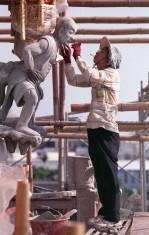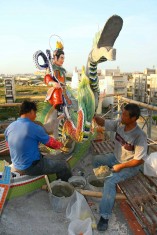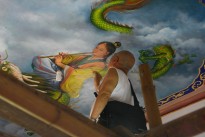TELDAP Collections
| Artisans of Temple Arts and Crafts |
|
Selective Preference of the 5th Cyber-Island Photography Contest Clay craft Craftsmen decorate the gold stove pagoda, sculpting and molding clay under the hot sun.
Temples in Taiwan are centers of religion and social activities for the neighborhood inhabitants. A small group of people have always quietly passed on the beauties of temple arts and crafts. These are the temple artisans. All the basic architecture, wood carving, color painting, decal pasting, cut-and-paste sculpture, clay works, koji sculpture, stone crafts, and face painting customarily portray some characters and their mounts, beam and column ornaments, flowers, birds, insects, fish, folk tales, and mountains and trees. People who live in the neighborhood will offer money and labor for the work on temple arts and crafts. In terms of the material and the design of outward appearance, almost all the finest and most delicate folk arts are congregated here. The display style shows off the gorgeous and complex characteristics of “nowhere is there no flower carving and color painting;” no space is left blank. This fully-decorated visual form is the feature of temple arts and crafts in Taiwan. In the meantime, the temple arts and crafts are just like other decorative arts, each artisan possesses his or her own artistic value and style which adds a different air and bearing to each temple. Temple arts and crafts are time-consuming and labor-intensive tasks which often require long hours of working on the roof. Some raw materials or semi-finished products have to be manufactured at the places of origin; others are done at the temple sites. The duration of construction can be as short as a few months or as long as several years. The intense expression and perseverance of these artisans and the delicate interaction between them and their work are obvious. Due to the religious faith and spiritual life, the temple arts and crafts are preserved entirely for hundreds of years in the temples.
To view Gold Prize of the 5th Cyber-Island Photography Contest, please go to The Funeral Orchestra. Text and images are provided by Exhibition of Cyber Island, Taiwan
|


















